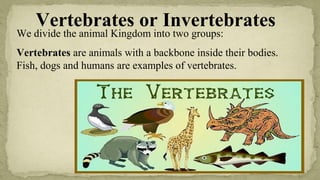
2nd qtr 8a characteristics of vertebrates
- 1. Vertebrates or Invertebrates We divide the animal Kingdom into two groups: Vertebrates are animals with a backbone inside their bodies. Fish, dogs and humans are examples of vertebrates.
- 2. Vertebrates or Invertebrates Invertebrates do not have a skeleton. Some examples of these are spiders, flies and caterpillars. Vertebrates are often larger and have more complex bodies than invertebrates. However, there are many more invertebrates than vertebrates.
- 3. Cold-blooded vertebrates depend on their surroundings to keep their body temperature. When there is no sun, and the air is cold, the animal gets cold. When it is sunny and hot, the animal gets hot, and generally more active. Vertebrates
- 4. Vertebrates • Warm-blooded vertebrates are types of animals that regulate their own body temperature and they normally have layers of fat, feathers or fur. Mammals and birds are warm-blooded.
- 5. Vertebrate classes Class Main features Examples amphibians moist permeable skin frog, newt, salamander fish gills, wet scales goldfish, shark, cod reptiles dry scales crocodile, lizard, snake birds feathers, beaks budgerigar, sparrow, ostrich mammals fur, produce milk rabbit, kangaroo, human, dolphin
- 6. Fish • Fish breathe through gills, and live in water. • They have scales and fins. • Most are cold-blooded and lay eggs (sharks are fish, but they give birth to live young).
- 7. • Amphibians are cold- blooded and live in water as tadpoles (breathing through gills) and on land as adults (breathing with lungs). • The main types of amphibians are frogs and toads, and salamanders. Amphibians
- 8. • Reptiles are cold-blooded and breathe with lungs. They have scales, and most lay eggs. • Reptiles include snakes, turtles and tortoises, crocodiles and alligators, and lizards. • Dinosaurs were reptiles, although some scientists believe that some were warm blooded. • Reptiles are more common in the tropics than in warm regions and are not found in polar areas. Reptiles
- 9. Birds •Birds are warm-blooded animals with feathers and wings. • They lay eggs, and most can fly (although many, including penguins and ostriches, can’t fly). • Because birds are warm- blooded, their eggs have to be incubated to keep the embryos inside warm, or they will perish.
- 10. Mammals • Mammals are warm- blooded, and are nourished by their mothers’ milk; most are born live (however, the platypus lays eggs). • Most mammals also have body hair. •We, humans, are mammals too.
